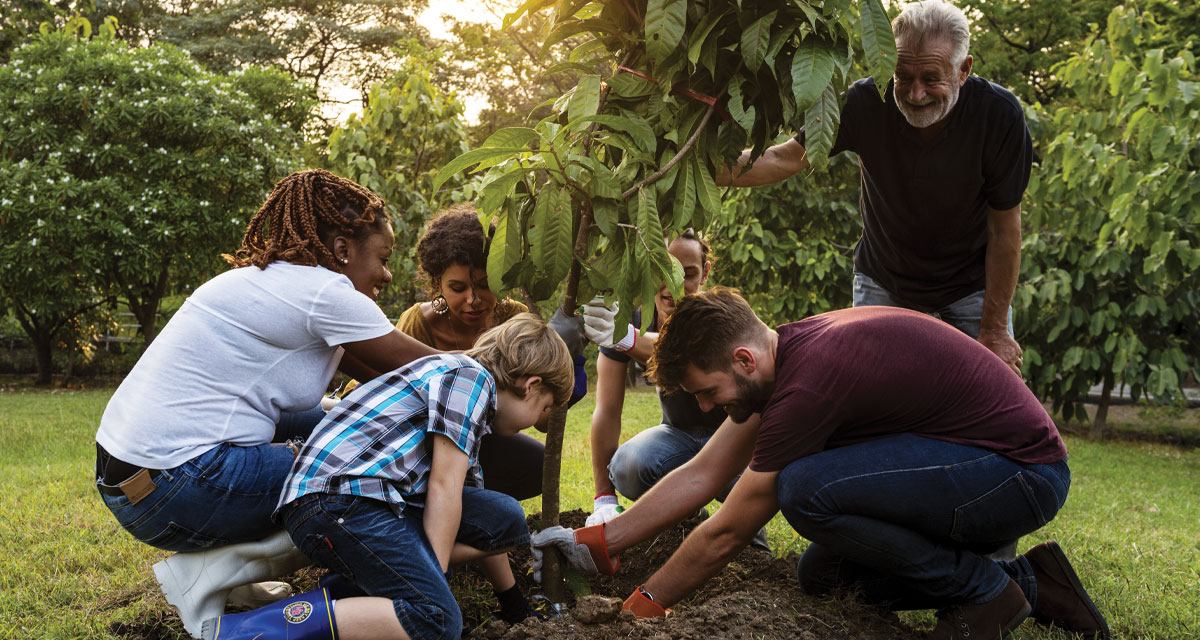It’s time to plant a tree, a tree. What shall it be? What shall it be? Let’s plant a maple—more than one, to shade us from the summer sun. Let’s plant a birch, an oak, a beech, there’s something extra-nice in each…in winter, summer, spring or fall. Let’s plant a…why not plant them all? ~ Aileen Fisher
While not deemed sacred or worshiped in our culture, a mature tree reaching the heavens has a spirit benefiting all of the earth’s inhabitants, from communities of birds, insects, and lichen to children and adults. It’s no wonder we find the living green world attractive. We live, work, and invest in green surroundings, striving for health and happiness. Is it odd to think people wrap their arms around a tree in appreciation of its many gifts? The mere sight of trees provides the onlooker with a feeling of serenity. The act of hugging, despite the discomfort of bark, increases levels of the feel-good hormone oxytocin? As a vital part of survival, you, too, can be an advocate, from leaf and limb to trunk and roots.
Environmental Value
Of the 600 species of oak trees in the world, 90 varieties exist in the United States. It is one of the oldest, most majestic shade trees, and drastically improves diverse ecosystems, living, on rare occasions, 1,400 years. Of the 10,000 acorns that drop yearly from trees 50 years old and older, only one will take root and grow. Oaks, believed by some to have a pest control problem, lure over 530 species of caterpillars to support the dwindling population of other creatures, such as baby birds. Without 5,000 caterpillars to feed a clutch of chickadees or up to 9,000 to feed bluebirds from hatching to fledgling, our populations decrease further. As you select a tree, determine whether your goal is to benefit the environment. The Bradford pear offers no nutritional value, and crape myrtles, walnuts, chestnuts, and holly trees also rate low! Combining benefits and beautification, consider varieties of alder, ash, beech, blackthorn, crab apple, elm, hazelnut, hawthorn, maple, Scots pine, or willow. If you have a mature tree, start hanging bird feeders from the branches!
Welcoming Pollinators
The buzzing occurring from spring through early fall could create a design of spirals, zig-zags, and beelines across the air to resemble—a Jackson Pollock painting? With so much activity from bats, bees, birds, butterflies, hummingbirds, moths, and wasps, humans often resort to using chemicals and traps in hopes of deterring particular creatures from entering their property. From maples and oaks to flowering trees, such as the tulip poplar, Juneberry, and other fruit trees, our world desperately needs every pollinating visitor. Add housing for birds, bats, and bees as a welcome and, not to forget, a water source! And a few rocks in the birdbath to ensure small insects can drink safely!
Abundant Fruit
In planting a backyard garden, think big and look to the skies! Just imagine harvesting 100 pounds of pears or 150 pounds of apples each year from one tree! The combined effort from pollinators and you provides a beneficial reward! Not all fruit varieties can pollinate themselves; examples are apple, pear, plum, and sweet cherry trees. In such cases, a second variety planted will ensure a large harvest. Other fruit trees, such as apricot, nectarine, peach, and sour cherry can thrive without a companion. Research before you invest in a dwarf or semi-dwarf variety. Bees are bound to come, especially to soft-flesh fruit trees. Careful planning and placement can create a happy balance for humans and winged flyers!
The Balance of Land
Soil surrounding trees is a storage place for water, nitrogen, and minerals to sustain a tree throughout its life. As it grows, roots extend, reaching out for water, usually near the surface. It’s no wonder we find happiness among wooded places or sheltered by the shade of protective limbs!
The best time to plant a tree is in the early spring and fall seasons.
*Lisa Doss is an NC State Extension Master Gardener Volunteer and a State Certified Beekeeper.



















